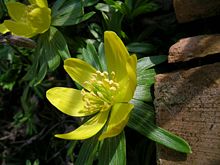Eranthis hyemalis
| Eranthis hyemalis | |
|---|---|

| |
| Scientific classification | |
| Kingdom: | Plantae |
| Clade: | Tracheophytes |
| Clade: | Angiosperms |
| Clade: | Eudicots |
| Order: | Ranunculales |
| Family: | Ranunculaceae |
| Genus: | Eranthis |
| Species: | E. hyemalis
|
| Binomial name | |
| Eranthis hyemalis | |

Eranthis hyemalis, the winter aconite, is a species of flowering plant in the buttercup family Ranunculaceae, native to calcareous woodland habitats in France, Italy and the Balkans, and widely naturalized elsewhere in Europe.[1]
Description
[edit]It is a tuberous-rooted herbaceous perennial growing to 15 cm (6 in), with large (2–3 cm (1–1 in)), yellow, cup-shaped flowers held above a collar of 3 leaf-like bracts, appearing in late winter and early spring. The six sepals are bright yellow and petaloid, and the petals are of tubular nectaries.[2] There are numerous stamens and usually six unfused carpels. The fruit are follicles each containing several seeds.[3]: 104
As a spring ephemeral plant, its life cycle exploits the deciduous woodland canopy, flowering at the time of maximum sunlight reaching the forest floor, then completely dying back to its underground tuber after flowering.
Names
[edit]The Latin specific epithet hyemalis means "winter-flowering",[4] while the name of the genus is a compound of the Greek elements Er 'Spring' and anthos 'flower' - so named for its early flowering.[5]
Cultivation
[edit]The plant is valued in cultivation as one of the earliest flowers to appear.[6] E. hyemalis[7] and the sterile hybrid cultivar 'Guinea Gold'[8] have gained the Royal Horticultural Society's Award of Garden Merit.[9]
Toxicity
[edit]All parts of the plant are poisonous when consumed by humans and other mammals,[10] because it contains cardiac glycosides similar to those present in Adonis vernalis.[citation needed] Glycosides of this type stimulate the heart when administered in small doses, but in very large doses may cause serious, often irreparable heart damage. Poisoning symptoms include colicky abdominal pains, nausea, vomiting, diarrhoea, disturbed vision, dyspnea, bradycardia, and, in severe cases, cardiac arrest.[11] Specific cardiac glycosides present in E.hyemalis include Eranthin A and B, belonging to the bufadienolide group,[12] also found in (and named for) the toad venom bufotoxin.
References
[edit]- ^ Bulbs by Phillips, Roger and Rix, Martyn, ed. Brian Mathew, pub. Pan (Garden Plants Series) 1989
- ^ Liangqian, Li; Tamura, Michio (2001). "Eranthis, Salisbury, Trans. Linn. Soc. London 8: 303. 1807, nom. cons". Flora of China. 6: 148–149.
- ^ Stace, C. A. (2010). New Flora of the British Isles (3 ed.). Cambridge, U.K.: Cambridge University Press. ISBN 9780521707725.
- ^ Harrison, Lorraine (2012). RHS Latin for gardeners. United Kingdom: Mitchell Beazley. p. 224. ISBN 9781845337315.
- ^ Royal Horticultural Society Dictionary of Gardening pub. Oxford University Press 1984 Volume II Cochemia-Javanicus
- ^ RHS A-Z encyclopedia of garden plants. United Kingdom: Dorling Kindersley. 2008. p. 1136. ISBN 978-1405332965.
- ^ "RHS Plant Selector - Eranthis hyemalis". Retrieved 28 January 2020.
- ^ "RHS Plant Selector - Eranthis hyemalis (Tubergenii Group) 'Guinea Gold'". Retrieved 28 January 2020.
- ^ "AGM Plants - Ornamental" (PDF). Royal Horticultural Society. July 2017. p. 35. Retrieved 6 February 2018.
- ^ Grunwald, D.; Lütkefels, E.; Wohlsein, P. (2002-10-01). "Intoxication of a dog with winter aconite (Eranthis hyemalis)". Kleintierpraxis. 47 (10). ISSN 0023-2076.
- ^ STARÝ, František, Poisonous Plants (Hamlyn colour guides) – pub. Paul Hamlyn April, 1984, translated from the Czech by Olga Kuthanová.
- ^ "Archived copy". Archived from the original on 2014-03-18. Retrieved 2016-05-10.
((cite web)): CS1 maint: archived copy as title (link)
External links
[edit]
Text is available under the CC BY-SA 4.0 license; additional terms may apply.
Images, videos and audio are available under their respective licenses.
